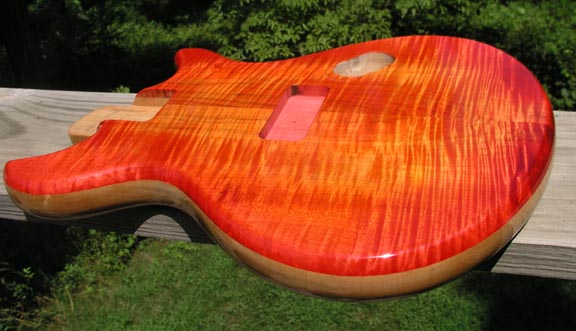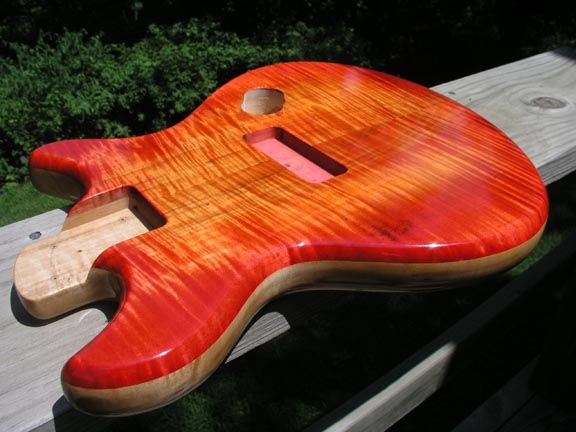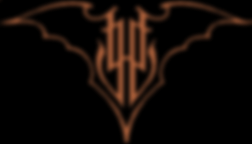
Doublecutaway Jr.

This is my version of one of the most popular electric guitars ever. The Arcadia doublecutaway design lends itself nicely to this configuration and my pickguard shape further compliments the instrument.
The edges of the instrument are mechanically rounded, as opposed to the contour carving I do on so many of my guitars. It doesn't have the parabolic finesse of my hand shaping, but it does still have a nice round look and is very comfortable. By limiting the edge shaping to that produced by the router, I've eliminated a large amount of hand labor which keeps this instrument one of my more affordable models. The historical Junior has fairly square edges, but I just can't bring myself to build a 2-dimensional cookie cutter guitar.

(I'd like to thank the new owner - David Lawrence of Nashville, TN - for snapping the above pics of the instrument for me.)
The body is one of the most beautiful examples of basswood I've worked with, topped off with flamed maple. Basswood takes a bad rap as a cheap or second-class material for guitars, but in my experience, basswood is an excellent choice for electric guitars. It may be a bit softer than most hardwoods, but no moreso than say Spanish cedar, which is frequently used by high-end builders. A good, dense basswood works smoothly and consistently and produces a decent tap tone to boot. In fact, builder John Suhr dubs this very configuration - basswood with a maple top - his holy grail of tone production. And some of the most incredible wood sculpture throughout art history has been produced using this particular species or related.



The above photos illustrate the finish and color. Believe it or not, this is Tru-oil, my preferred wiping varnish. The only finish thinner than my wiped and hand-rubbed finishes are penetrating oil finishes, which don't quite afford the scratch-resistance Tru-oil does. While Tru-oil isn't as scratch-resistant as polyurethane, an instrument finished with it isn't completely enrobed in vibration-damping plastic. Rubbed-out Tru-oil also has just a wonderful feel. It's not sticky or squeeky like glossy lacquers or urethanes. Even buffed out to a high gloss, this wiped-on varnish is as smooth and slick as silk.
By the time the guitar is finished, I'll have applied from 20-25 applications. Since my technique also involves leveling and rubbing out at specific stages, the final finish is perhaps only 8-10 applications thick, if that. I've heard it said by a number of good luthiers that it's not about how much finish you put on, but how much you leave on.
The following photograph shows the unique ebony inlay or "tattoo" I did on either side of the neck volute.

The Arcadia DC Jr. shown is sold, but sells for $2,800* as shown and described, including hardshell case.
*This instrument is not sculpturally carved or contoured, falling into my entry level category and priced accordingly. My carved and contoured guitars begin at $4,400.
Specifications
Body: solid basswood w/flamed maple top
Neck: walnut bolt-on w/dropped-down 3x3 headstock, dual-action trussrod
Fretboard: Indian rosewood, 25" scale, 24 frets, mother of pearl markers
Nut: graphite, 1 11/16" in width
Pickups: single P90
Switching: single volume control only
Bridge: commercial hardtail
Tuners: black 3x3s
Finish: aniline dye and Tru-Oil
